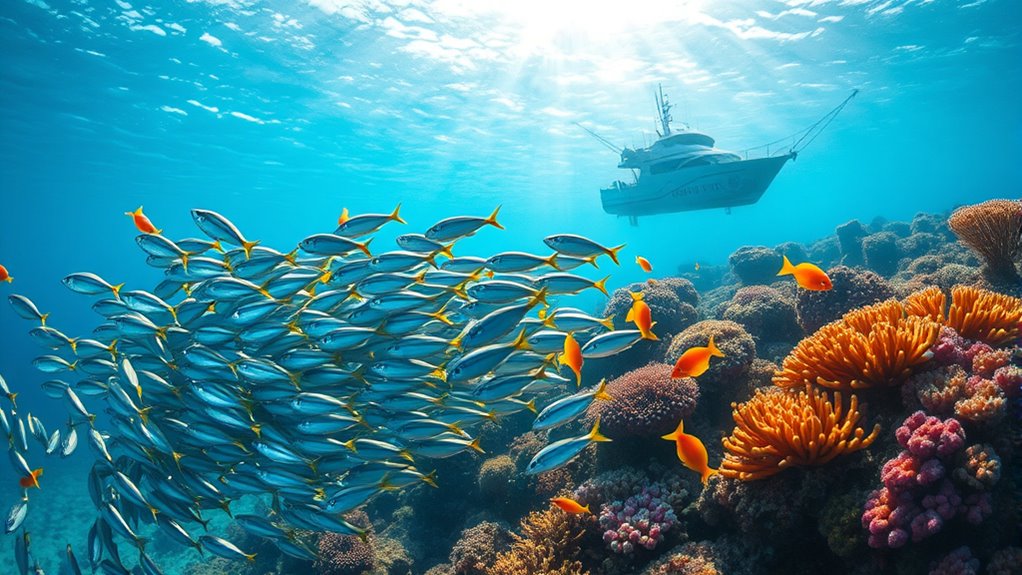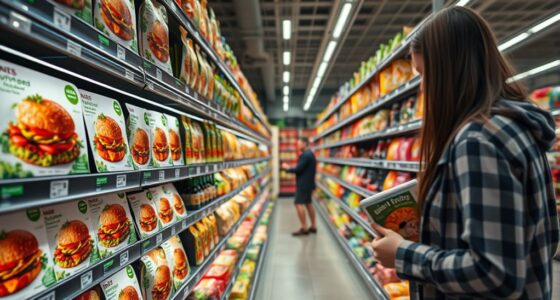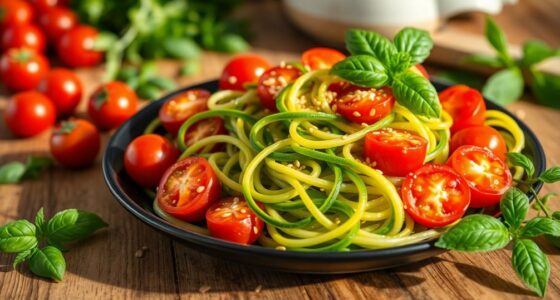To support marine health and guarantee future seafood availability, choose sustainable options marked by reputable certifications like MSC or ASC. Opt for fishing methods such as pole-and-line or handline, which minimize bycatch and habitat damage. Be mindful of regional overfishing and farm practices by researching or asking questions. Using seafood guides or apps helps you make informed, eco-friendly choices. If you keep exploring, you’ll discover more ways to make a positive impact on ocean conservation.
Key Takeaways
- Look for certifications like MSC or ASC on seafood packaging or menus to identify sustainable options.
- Choose fishing methods such as pole-and-line or handline, which are more environmentally friendly and reduce bycatch.
- Be aware of regional fishing practices; support fisheries that are well-managed and transparent about their sustainability efforts.
- Consider farmed seafood that follows responsible aquaculture practices, including water quality and waste management.
- Use seafood guides, apps, or resources to stay informed about sustainable choices and support conservation-minded fisheries.

Have you ever wondered whether the seafood on your plate is caught responsibly? It’s a question that matters more than ever as overfishing and environmental degradation threaten marine ecosystems. When you choose sustainable seafood, you’re helping to preserve fish populations and protect the oceans for future generations.
Wondering if your seafood is responsibly caught? Choosing sustainable options helps protect marine life for future generations.
But how can you tell if the seafood you’re buying or eating is genuinely sustainable? The answer lies in understanding the certifications, fishing methods, and sources behind your seafood.
Sustainable seafood is caught or farmed in ways that maintain healthy fish populations and minimize environmental impact. One of the most trusted indicators of responsible sourcing is certification from organizations like the Marine Stewardship Council (MSC) or Aquaculture Stewardship Council (ASC). These certifications involve rigorous assessments of fishing practices, stock health, and environmental impact.
When you see their logos on packaging or menus, it’s a good sign that the seafood meets established sustainability standards. However, certifications aren’t the only way to gauge sustainability. You should also consider the method used to catch or farm the seafood.
For example, fishing methods like pole-and-line or handline fishing tend to be more sustainable because they selectively target individual fish, reducing bycatch and habitat damage. Conversely, trawling and large-scale net fishing often cause significant bycatch—unintended catch of other species—and damage to seabed habitats.
When shopping or dining, ask about the fishing method if it’s not clearly labeled. Many fisheries are adopting more eco-friendly practices, so choosing seafood from responsible sources encourages sustainable industry practices.
Location also plays a critical role. Fish caught in overfished regions or during certain times of the year can contribute to stock depletion. Look for seafood from well-managed fisheries with transparent reporting.
Some regions have strict regulations and effective management plans, making their catch more likely to be sustainable. Additionally, farmed seafood can be sustainable if produced responsibly, with attention to water quality, feed, and waste management. Always research or ask about the farm’s practices before making a purchase.
Moreover, ensuring the use of appropriate oil in processing or equipment maintenance supports optimal performance and longevity of gear used in sustainable fishing practices. Staying informed is key. Use resources like seafood guides, apps, or websites that provide updates on fish stock health and sustainable options.
By making mindful choices, you support fisheries that prioritize conservation and responsible harvesting. Every time you choose sustainable seafood, you’re contributing to healthier oceans, thriving fish populations, and a more sustainable future.
Your choices do matter—so next time you’re at the store or ordering at a restaurant, remember that being informed and conscientious can make a real difference in promoting seafood sustainability.
Frequently Asked Questions
How Does Seafood Sustainability Impact Local Fishing Communities?
You’re curious about how seafood sustainability affects local fishing communities. When sustainable practices are prioritized, your community benefits from healthier fish populations, ensuring long-term income and food security.
It encourages responsible fishing, which prevents overfishing and habitat destruction. This creates stable jobs and supports local economies.
Conversely, ignoring sustainability can lead to resource depletion, risking livelihoods and future fish stocks. So, sustainable fishing practices are essential for your community’s economic and environmental well-being.
What Are the Environmental Risks of Overfishing?
Overfishing poses serious environmental risks that you should be aware of. It depletes fish populations faster than they can replenish, leading to the collapse of ecosystems.
This disrupts food chains and harms other marine life. Additionally, it causes habitat damage, like destroying coral reefs and seafloor environments.
How Can Consumers Identify Sustainable Seafood Options?
To identify sustainable seafood options, you should look for eco-labels like MSC or ASC, which indicate responsible fishing practices.
Check reputable guides or apps that rank seafood based on sustainability.
Ask your fishmonger or restaurant about the origin of their seafood, and prefer locally sourced or seasonal options.
What Role Do International Regulations Play in Seafood Sustainability?
Did you know that over 90% of global seafood trade is regulated by international agreements? These regulations set standards for sustainable fishing practices, helping to protect marine ecosystems.
By supporting products compliant with these rules, you actively promote responsible harvesting. International regulations guide fisheries toward better management, ensuring fish populations stay healthy.
Your choices can influence global efforts, making a real difference in maintaining seafood abundance for future generations.
How Does Aquaculture Affect Marine Ecosystems?
Aquaculture impacts marine ecosystems in both positive and negative ways. When done responsibly, it can reduce pressure on wild populations and provide a sustainable seafood source.
However, if poorly managed, it can lead to habitat destruction, water pollution, and the spread of diseases. You should consider supporting certified sustainable farms and advocating for best practices to minimize environmental harm and promote healthy ocean ecosystems.
Conclusion
You now hold the power to make a difference, just like the guardians of the ocean before you. By choosing sustainable seafood, you’re not just feeding yourself—you’re preserving a fragile world teeming with life. Imagine a future where vibrant reefs and abundant fisheries thrive, echoing the timeless promise of hope and renewal. Remember, each mindful choice is a stroke in the masterpiece of a healthier planet—your actions today shape tomorrow’s ocean.









